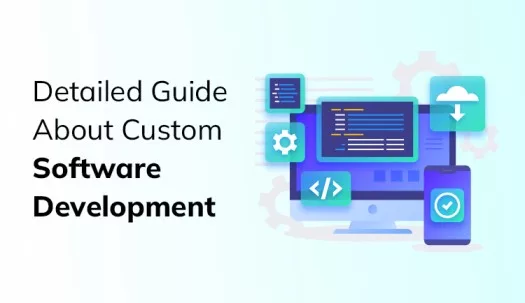Custom Software Development: A Comprehensive Guide

The rapidly changing software industry landscape allows businesses to continuously improve their processes and infrastructure in order to thrive. With the abrupt shift in the digital paradigm, many businesses now consider custom software development to be a necessity rather than a luxury.
They assist businesses in improving the customer experience and gaining a competitive advantage. Furthermore, they aid in identifying customer pain points and assisting businesses in forecasting future demand.
Custom software development allows you to build scalable and customer-focused software applications the way you want by leveraging the power of evolving technologies. Companies are frequently faced with the dilemma of deciding between customized software and ready-made software (off-the-shelf).
This article will assist businesses looking for custom software development services in understanding the critical aspects of developing customized software.
What exactly is customized software?
Commercial Off The Shelf (COTS) software is software that comes pre-packaged with features. The vendor who created it is responsible for updating its versions, and businesses subscribe to it by paying a licensing fee. It is designed with the most universal needs of the mass market in mind. COTS products include Microsoft Windows. It provides the tools for each user to perform everyday computational tasks without hesitation.
Customized software, on the other hand, is software that you create or have a third party create for you. It is also known as bespoke software because it is designed and developed to meet the user’s specific needs. It is made to order and focuses on features that are important to the organization. Custom software applications are designed to meet current and future business needs.
Custom software apps can complete tasks that would otherwise take a long time with standard software in a matter of seconds. Consider COTS to be a public utility vehicle that considers the combined choices of travelers and drives at a fast enough speed to pacify those onboard. While custom software is like a private car, you can customize it to your liking and exceed speed limits.
Now that you know what custom software is, let’s look at the development process used by a full-cycle app development company.
Is the Custom Software Development Process Distinct from the Standard Process?
Absolutely not. In both cases, the software development life cycle is nearly identical. You go through the same stages of gathering primary information, coding, testing the software for inconsistencies, and finally deploying it.
Enterprises are under unprecedented pressure to transform digitally in order to survive. Each is attempting to distinguish itself and establish itself as an innovator. Custom application development, whether in-house or outsourced to a company like Owebest, involves the following stages:
Application personalization
You could either buy off-the-shelf software and re-program it to meet your needs or create a custom solution. Whatever you choose, it will start at this stage of code creation.
Modernization of applications
Stakeholders gradually realize that their value chains must improve and become as impressive as their product suite. As new technologies emerge, the deployed custom software must be updated with new features.
Application administration
It is similar to after-sales support, but it is done internally or by a third party who designed the software for you. This includes everything from installing the software to ensuring its availability 24 hours a day, seven days a week.
What are the Advantages of Developing Custom Software?
It is not a good reason to purchase a subpar product and then modify it for installation. It’s better to design everything yourself! The following advantages of custom software application development will assist you in making your decision.
Independent vendor
You will be liberated from the clutches of vendors who upgrade their products based on user reception and trends rather than your needs if you create your own software. As a result, your company avoids fee increases associated with licensing and maintenance. Furthermore, the vendor may cease operations, shredding your IT department and jeopardizing business continuity.
Produce white-label goods
The resources you invest in developing a custom internal solution could be monetized by licensing it to similar businesses or allowing them to use it as a White Label product for a one-time fee. A White Label product is one that you create and sell to another organization in exchange for the right to use it under their brand name. The only catch here is that the terms of use must be defined. Although white-label solutions are not always considered effective in the long run, they can be a good option for entrepreneurs who are just getting started.
Integration at the highest level
When you discover that you need to program extensions into the system to make your investment worthwhile, it becomes a catch-22 situation. Spending the same money on custom software applications that work seamlessly with other software (because you created them) saves you time and energy.
Performance
Custom software development results in more stable and efficient IT operations because the software does everything (and possibly more) that is asked of it to deliver value-added results.
Scalability
Nobody knows your company’s future better than you. It becomes a self-fulfilling prophecy that you will create something scalable and relevant to your company’s needs during customized software application development.
Process optimization in business
Every organization has a strategy and internal processes. Businesses find it difficult to adapt their approach to a specific application, no matter how effective and powerful it may be. Software should be planned and developed to be compatible with the business model. Instead of replacing your business processes, custom software application development helps to improve them.
Compatibility
Most organizations have a design model in which the output of one process (software application or module) serves as an input for another. While streamlining business, a smooth flow of data is essential. Using different packaged programs for different processes can cause data flow issues. Building custom software can solve a variety of problems involving data flow between progressive processes.
Data safety
Data access and security issues are a major concern for some B2B and B2C organizations, and they have an impact on many end-users in the market today. With custom development, you can select the best data security technology or protocol for your company and integrate it into your software.
Cost-effectiveness
Custom development allows you to plan and stage the development process. You do not need to contribute a large sum of money to reap the benefits of automation. Depending on your budget and available funds, you can begin automating single process flows in a coordinated and planned manner, in the long run, to make software development more affordable.
Adaptability
Organizational processes evolve over time, and as market dynamics shift, it becomes increasingly important to adapt to new processes and innovations in order to maintain your marketing dominance. Customized software is easily changed – New cycles and innovations can be incorporated into your current programming as showcasing patterns change to keep up with your competitors.
How Do You Know If You Need a Customized Solution?
Companies have traditionally preferred to purchase COTS software that helps them meet up to 80% of the following business requirements:
- Take care of confidential data and proprietary information.
- Allow for ad hoc privacy concerns that may arise.
- Allow integration with the company’s existing software.
- Reduce operational costs while increasing return on investment
- Give the brand a certain level of competitive advantage.
Some businesses may be fine if the software delivers 60% efficiency rather than 80%, and they fill the void on their own. But leaving things to chance and making superficial digital transformation efforts is risky.
Startups make inroads into legacy businesses faster than others because they are not afraid to innovate. And if that requires introducing new digital solutions, so be it.
Prepare the Requirements
Once you’ve decided to pursue custom software development, the next step is to identify collaborators to assist you with internal project development. These include program sponsors, high-level stakeholders, your customers, and various other partners.
This step is all about communicating your digital transformation plans to the workforce, after which a detailed draft listing your key performance indicators (KPIs) must be prepared. KPIs must consider the following:
- To be realistic and flatten any statutory or theoretically unattainable targets
- Define the role that the proposed software will play in the development of the business.
- The software must not interfere with any pre-existing COTS software.
- There must be plenty of proof of concept in the market on which to base and validate your theory.
- The source code must be open-sourced or written from scratch and must not infringe on intellectual property rights.
- Budget and time constraints must be adhered to.
- If necessary, partial deviations/pivots from the initially agreed-upon course of action can be made.
Custom Software Development Costs and Risks
The cost of custom software development is an important step in software planning. Estimating the exact cost of development appears difficult due to the constantly changing characteristics of custom software, as you cannot risk the software’s success.
The cost of custom software development must be properly calculated in order for businesses to gain a competitive advantage over their competitors. It assists businesses in reducing risks while maintaining high software quality.
Factors Influencing the Cost of Custom Software Development
Calculating custom software costs is not as simple as it appears. Let’s look at a curated list of factors that influence your custom software development costs.
Size of software
One of the most important factors that may influence your software cost is the size of the software. The size of the software has a significant impact on the cost because it represents how much effort the developers must expend to develop the software. Large projects will cost you more because they are paid hourly, whereas smaller ones don’t take as long to develop.
Software Complicatedness
The complexity of your custom software development is another important factor that influences the cost. The software can be classified into three types: basic, moderate, and complex. The more complex your software, the greater the investment required.
Software design specifications
Software design is another important factor in estimating software costs.
The cost of designing software includes UX/UI design, architectural design, and basic website or app design. A website’s interface must be user-friendly, engaging, and capable of providing a consistent user experience. The more appealing your interface, the more likely it is to entice your intended users. As a result, the cost of design rises.
Methodology for software development
Agile, spiral, waterfall, hybrid, or iterative software development methodologies and approaches indicate how robust and scalable your software product or service will be.
Each methodology and approach has advantages and disadvantages; they all work differently and have different costs.
Outsourcing vs. in-house development teams
Creating custom software necessitates the collaboration of talented professionals, freelancers, or an in-house development team.
The cost of developing custom software varies depending on whether the team is in-house or outsourced. Hiring a fully remote development team, on the other hand, will be more expensive. This assumption, however, is not always correct. The cost of software development is determined by the developer’s expertise and experience. Hiring inexperienced and less skilled developers may result in a lengthy development process, whereas hiring developers with a diverse skill set will increase your company’s revenue.
Custom Software Development Pitfalls
Every piece of software that is created comes with its own set of risks. The same thing happens with customized software development, and there are certain pitfalls that can lead to project failures.
Let’s take a look at a few of them:
Communication breakdown
Lack of communication is one of the most common pitfalls in customized software development. Large communication gaps frequently result in project failures. Your custom software development partner must understand the project requirements, goal, scope, and timeline to ensure seamless communication. Team members should participate in all project discussions and meetings.
Incorrect Software Estimates
Teammates and project managers must communicate effectively about project details such as budget constraints, technical requirements, and deadlines. It enables software development teams to generate an accurate and precise project estimate as well as a clear roadmap for custom software development.
Failures of Products
Software products and processes are frequently created, monitored, and never upgraded. This may result in project failure because you have invested critical time, effort, and resources in developing that software product.
Focus Deficit
It is a difficult task to eventually involve yourself in the development of custom software. If you lose focus or lack a clear goal, your software development process will not run smoothly or in the right direction to achieve organizational goals.
Methods for mitigating risks in software development
Not only do risks present themselves, but solutions to mitigate those risks are also available to aid in the smooth development of customized software. Specific risk mitigation strategies paved the way for the software’s future growth and success.
MVP Development is a one-stop shop for all of your development needs
Innovative and customized software solutions can experiment with anything. To create scalable and customer-centric digital products, you must make more strategic and informed decisions.
MVP development is one way to get started with custom development. It is an iterative process that provides you with an innovative digital product with few features and a low price. With this advancement, you can put your product idea to the test and turn it into a reality.
Agile methodology must be used
By incorporating agile methodology into your business processes, you can get the right customized product and manage business processes in a series of sprints.
With each iteration/sprint, you can add, modify, or delete modules in accordance with agile practices. It increases the scalability and flexibility of your product and business processes. You must incorporate new features and functionality into your product to keep up with the rapidly changing trends in software development.
Communication Process That Is Consistent And Seamless
Misunderstandings between team members are caused by improper communication gaps or loopholes, which is a major cause of software failures. To increase workplace productivity, a systematic and well-defined communication channel connecting every team member with managers and leaders is required.
Make sure you keep your clients informed. To avoid miscommunication, hold regular meetings and discussions. As a result, throughout the software development cycle, clear and flawless communication keeps all team members and leaders on the same page.
Complete all types of testing thoroughly
Following software development, all types of testing must be performed. It aids in the tracking of software errors, bugs, and flaws.
To identify and correct issues that may affect your software, testers must perform all types of testing. Testing at the beginning ensures that the software is robust and bug-free from start to finish.
Outsourcing vs. In-House Custom Software Development
Both in-house custom software development and custom software development outsourcing have advantages and disadvantages. The best fit is determined by your business goals and project requirements.
Hiring in-house development teams is more profitable for businesses because they understand how to develop custom products while also meeting business needs and company culture. Hiring and training a team of in-house developers, on the other hand, can be costly for your company.
While outsourcing software development allows businesses to access a large talent pool of outsourcing professionals, it also carries some risks because companies cannot fully control the development process.
According to Deloitte’s global outsourcing survey, 70% of organizations outsource with one goal in mind: cost reduction.
Advantages of Custom Software Outsourcing
Outsourcing custom software provides endless benefits to businesses today, which is why this software development is becoming increasingly popular.
1. You can concentrate on your core business areas
Outsourcing your software development process allows your development teams to spend more time focusing on their core technical skills. Furthermore, managers can now free themselves from the burdens of marketing, customer engagement, and the sales process associated with outsourcing.
2. Business processes can now be streamlined
You can streamline and accelerate your business processes by hiring a custom software development team. As a result, it ensures faster project completion. It will save you a lot of money on hiring and will not require you to pay if you do not have any projects.
3. You can count on high scalability
Businesses that outsource customized software development can easily scale their development team up and down. You can easily expand your development team in order to accelerate the development process. Eliminating unnecessary employees will lower your overhead costs and ensure you only hire remote developers you need.
4. You have a wide range of abilities
Outsourcing software development provides developers with a wide range of skill sets and a vast library of knowledge and expertise in modern technologies. You can select the best pool of professionals to provide an optimized and robust solution that meets your business requirements.
According to a recent Korn Ferry study, most countries are expected to face a tech talent shortage by 2030, potentially costing them $162 billion in revenue.
The Drawbacks of Custom Software Outsourcing
Despite its many benefits, you should be aware that custom software outsourcing has several drawbacks.
1. Different teams have different cultures
The cultural differences between the organizations are major challenges. It’s possible that the company is having trouble understanding your business requirements. However, because there is a time difference between the two countries, you can use it to conduct meetings and phone calls.
2. This results in security risks
One major issue that businesses frequently face when outsourcing custom software is a lack of face-to-face communication. To ensure the security of your company, you should prioritize signing an NDA contract with the second party. This agreement ensures that your rights and project ideas are protected.
3. The dangers of using unsupported code
If you outsource a critical product, make sure you maintain the code without the involvement of the outsourcing firm. On the contrary, your company will be dependent on the app development team that you outsource or the remote developers that you hire. It is critical to maintaining software integrity between the two parties. The integrity of the outsourcing firm determines the quality of the code.
The Advantages of In-House Custom Software Development
Hiring an in-house custom development team is an excellent way to begin developing innovative digital products. Here are some of the advantages you can enjoy.
1. You may have the extensive industry knowledge
As an integral part of the organization, in-house developers are well-versed in all aspects of the company’s clients, business-related tasks, projects, and so on. They have the authority to make changes to the development process if necessary. In addition, an in-house developer makes a significant contribution to the company’s culture.
2. There are no cultural differences
The in-house development team is made up of experts from the same region who have similar backgrounds and work for the same organization. Because all team members work the same hours, communication is smooth and clear.
3. You have a knowledgeable in-house expert
In-house developers have the technical skills required to create custom software. They contribute significantly to the development of customized solutions. This will aid in the elimination of bugs and the creation of transparency during product development. The development teams have the necessary skills to create and maintain scalable products on their own.
The Drawbacks of In-House Development
Instead of benefits, in-house custom development has some drawbacks that you should be aware of.
1. It comes at a high price
To begin custom development, your company will need to invest heavily in an in-house development team. Skilled developers are in high demand, resulting in high salaries, and employees receive additional benefits such as healthcare and vacation plans. As your team grows, your overhead will rise.
2. The procedure is time-consuming
Hiring a qualified and experienced candidate is a time-consuming process. When you outsource your customized software development, you can work with a team of experienced and skilled professionals. It allows the project to get started in a fraction of the time it would take to build an in-house team.
3. A scarcity of expert talent
The ever-changing software industry necessitates a high demand for software professionals. In some areas, it can be difficult to find qualified candidates. Furthermore, it is difficult to find a developer who will fit your budget and meet your business requirements.










